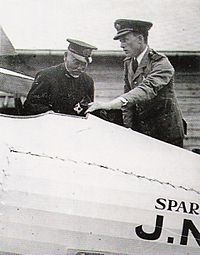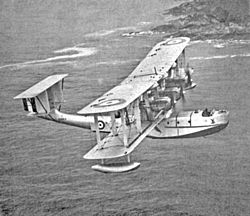William Forbes-Sempill, 19th Lord Sempill facts for kids
Quick facts for kids
The Lord Sempill
AFC
|
|
|---|---|

Captain Sempill showing a Gloster Sparrowhawk plane to Admiral Count Tōgō Heihachirō in 1921.
|
|
| Born |
William Francis Forbes-Sempill
24 September 1893 |
| Died | 30 December 1965 (aged 72) |
| Nationality | British |
| Other names | Master of Sempill |
| Education | Eton College |
| Occupation | Aeronautical engineer, pilot, diplomat, spy |
| Years active | 1914–1941 |
| Organization | President of the Royal Aeronautical Society |
| Known for | Aviation Sempill Mission Spy for Japan |
| Predecessor | John Forbes-Sempill, 18th Lord Sempill |
| Successor | Lords seat: Ann Forbes-Sempill Baronetcy: Sir Ewan Forbes, 11th Baronet |
| Political party | Conservative |
| Spouse(s) | Eileen Marion Lavery (1919–1935) Cecilia Alice Dunbar-Kilburn (1941–1965) |
| Children | Ann Moira, June Mary (by 1st marriage) Janet Cecilia, Kirstine Elizabeth, Brigid Gabriel (by 2nd) |
| Awards | Order of the Rising Sun, Japan Order of the Polar Star, Sweden. |
William Francis Forbes-Sempill, 19th Lord Sempill (born September 24, 1893 – died December 30, 1965) was a Scottish noble and a famous pilot. He broke many flying records. Later, it was found that he had shared secret information with the Japanese military before World War II.
William went to Eton College, a famous school. He started his career as a pilot in the Royal Flying Corps. He also served in the Royal Naval Air Service and Royal Air Force during World War I. In 1921, Sempill led a special group to Japan. They showed off the newest British airplanes. In the years that followed, he kept helping the Japanese Navy develop its air force.
In the 1920s, Sempill started giving military secrets to Japan. British intelligence (called MI5) found out what he was doing. However, Sempill was not put on trial for spying. He was allowed to continue his public life. He was eventually asked to leave the Royal Navy in 1941. This happened after he was caught passing secret information to Japan. This was just before Japan attacked Pearl Harbor and declared war on the United States and the British Empire.
Before he became Lord Sempill in 1934, he was known as "Master of Sempill." He inherited his titles from his father, John Forbes-Sempill, 18th Lord Sempill.
Contents
Early Life and Education
William Sempill was born at Craigievar Castle in Aberdeenshire, Scotland. This was his family's home. He went to Eton College for a year. In 1907, he ran away from school and went back to Craigievar. After this, he was taught at home by private teachers.
In 1910, Sempill started working for Rolls-Royce Limited. He was learning how to build cars and engines. In 1913, he wanted to join an expedition to the Antarctic. He planned to be in charge of weather studies. But World War I started, so the trip was cancelled.
Military and Civilian Flying Career
When World War I began, Sempill joined the Royal Flying Corps. He quickly became a pilot and was promoted several times. He worked as an "experimental officer" at a flying school. He also became a flight commander.
At the end of 1915, he joined the Royal Naval Air Service. He continued to rise in rank. In 1918, the flying services joined to form the Royal Air Force. Sempill became a deputy director in the RAF. He received the Air Force Cross for his service. After the war, he became a test pilot, flying new aircraft. He left the military in 1919.
Sempill was a record-breaking pilot. On September 4, 1930, he flew a de Havilland DH.80 Puss Moth seaplane. He flew 1,040 miles without stopping. This flight was from London, England, to Stockholm, Sweden, and took 12 hours.
On March 26, 1936, he set another record. He flew a very light BAC Drone plane. He flew 570 miles from Croydon Airport in England directly to Berlin Tempelhof Airport in Germany. This flight took 11 hours. He flew back a day later in 9 hours.
In 1931, Sempill became the head of National Flying Services. This company owned and ran London Air Park, Hanworth. He hosted visits from important people. These included members of the Japanese Royal Family and the German airship LZ 127 Graf Zeppelin.
Sharing Secrets with Japan
In 1920, William Sempill led a group of British pilots to Japan. They went to help Japan build aircraft carriers. They also helped the Japanese navy set up its new air base. Britain hoped to sell many aircraft to Japan. Sempill was well-liked in Japan. The Japanese Prime Minister thanked him for his important work with the Imperial Japanese Navy.
The alliance between Britain and Japan ended in 1921. This meant close military talks should have stopped. But Sempill kept in touch with the Japanese Embassy in London. He continued to discuss aviation technology and tactics.
Becoming Suspected
In 1925, Sempill visited the Blackburn Aircraft factory. He was with other foreign air officials. The Japanese had already asked about new aircraft being built there. Sempill later asked the same questions about a secret plane called the Blackburn Iris.
British intelligence (the Directorate of Military Intelligence) had been watching Sempill since 1922. They knew he was talking to a Japanese intelligence officer. They found out Sempill was giving secret information to Japan. The Japanese officer's messages suggested Sempill was paid for this. MI5 listened to Sempill's phone calls. They also noticed his servant was a Japanese naval officer.
In 1926, Sempill was considered for a job as an aviation advisor for Greece. But British intelligence warned against it. They told the government about his past activities.
Sempill was called to the Foreign Office for a meeting. They wanted to know how loyal he was to Britain. They also wanted to know how much information he had given to Japan. The officers could not tell him they had secretly read Japanese messages.
Sempill had openly talked about the Iris flying boat on a train trip. A British government worker saw this and reported it. When faced with this, Sempill admitted he had broken the Official Secrets Act. This law protects government secrets.
A meeting was held to decide what to do. The leaders decided not to put Sempill on trial. First, Sempill's father was close to King George V. A public trial would have been very embarrassing for the Royal Family and the British government. Second, a trial would have shown Japan that Britain could read their secret messages. This would have hurt Britain's intelligence efforts.
After the Warning
Six years after admitting he broke the law, Sempill became a consultant for Mitsubishi Heavy Industries. From 1932 to 1936, he worked for this Japanese company in Europe. He also became the head of the Royal Aeronautical Society. In this role, he advised other countries, like Australia, on how to create their naval air forces.
In 1933, Sempill was hurt in a car accident in the United States. He was riding in a special experimental car. The car crashed, and Sempill was injured.
In 1934, he became Lord Sempill after his father passed away. His first wife died in 1935. He remarried in 1941 to Cecilia Dunbar-Kilburn.
Sempill had strong right-wing political views in the 1930s. He was part of groups like the Anglo-German Fellowship.
Spying During World War II
When World War II started in 1939, Sempill got a job at the British Admiralty. This gave him access to secret information about British aircraft.
By June 1941, MI5 found messages showing Sempill was still being paid by Japan. These messages were between London and Tokyo. They suggested Sempill was giving away top-secret information about British naval aircraft. The government decided not to prosecute him again. Instead, he was given a "strict private warning."
In August 1940, a Japanese businessman named Makihara Satoru was arrested. He was the head of Mitsubishi Corporation's London office. Sempill called the police station and visited to say Makihara was innocent. Makihara was released a few days later.
Sempill was also likely passing on details about the British government. In August 1941, Winston Churchill and President Franklin D. Roosevelt met. They discussed the threat from Japan. Soon after, secret messages between the Japanese embassy in London and Tokyo were read by British code breakers. These messages contained notes from the meeting. Churchill was very worried. He thought only two people could be the source of these leaks, and Sempill was one of them.
On October 9, 1941, Churchill ordered that Sempill be removed from his job. The Admiralty told Sempill he had to resign or be fired. Churchill later changed his mind slightly. He said Sempill should be moved to a different job, perhaps in Scotland.
On December 13, 1941, Sempill's office was searched. This was six days after the attack on Pearl Harbor. Secret documents were found that he should have returned. Two days later, Sempill was caught making phone calls to the Japanese Embassy. Even with this evidence, he was not arrested or put on trial. Sempill agreed to leave public office.
Personal Life
In 1919, Sempill married Eileen Marion Lavery. She was the daughter of a famous Irish painter. Their first daughter, Ann Moira, was born in 1920. Their second daughter, June Mary, was born around 1923. Sadly, June Mary died at age 18 during an enemy attack in London in 1941. She was helping with the WVS Mobile Canteen Service. After his first wife died in 1935, Sempill married Cecilia Dunbar-Kilburn in 1941. She was a sculptor.
Sempill became a Roman Catholic in the early 1930s. He was also a druid and a Cornish bard.
Later Years and Passing
In 1944, Lord Sempill visited Nova Scotia, Canada. He offered to buy part of the province. In 1956, the Swedish government gave him the Order of the Polar Star award. He was also the president of the British Gliding Association and the Institute of Advanced Motorists. In 1963, he sold Craigievar Castle to the National Trust for Scotland.
William Sempill passed away in Edinburgh on December 30, 1965. His daughter, Ann, inherited his title of Lord Sempill. This was because her family's peerage could be passed to a female heir. However, his other title, the baronetcy, could only be passed to a male. This title went to his younger sibling, Ewan Forbes. Ewan had been registered as female at birth but lived as a man. This inheritance was challenged but upheld in court.
Legacy and Reasons
It was not until 1998 and 2002 that Sempill's spying activities became widely known. This happened when intelligence records were released to the public.
It is still not fully clear why Sempill shared secrets. Some records suggest his actions were not to help the enemy. Instead, they might have been due to his strong personality, stubbornness, and poor judgment.
Documents from the 1940s show that Sempill had many debts. He owed a lot of money, which might have been a reason for his actions.
Awards and Honors
- Air Force Cross (AFC)
- 3rd Class of Commander in the Order of the Rising Sun, Japan.
- Order of the Polar Star, Sweden.
See also
- Frederick Rutland, a British naval pilot and Japanese spy
- John Semer Farnsworth, an American naval officer and Japanese spy


